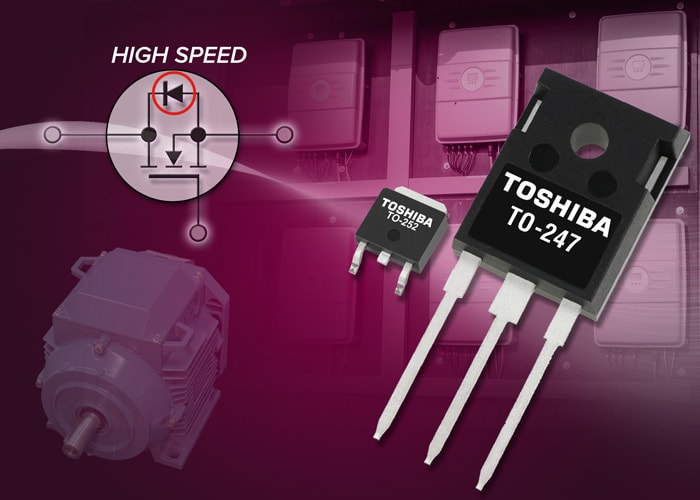- General Top
- SEMICONDUCTOR
- STORAGE
- COMPANY
-
My ToshibaSemicon
- Semiconductor Top
-
ApplicationsAutomotive
Body Electronics
xEV
In-Vehicle Infotainment
Advanced Driver-Assistance Systems (ADAS)
Chassis
IndustrialInfrastructure
BEMS/HEMS
Factory Automation
Commercial Equipment
Consumer/PersonalIoT Equipment
Healthcare
Wearable Device
Mobile
Computer Peripherals
-
ProductsAutomotive Devices
Discrete Semiconductor
Diodes
Transistors
Logic ICs
Analog Devices
Digital Devices
Wireless Devices
※
: Products list (parametric search)
Power Semiconductors※
: Products list (parametric search)
Isolators/Solid State RelaysPhotocouplers
Digital Isolators
Solid State Relays
Fiber Optic Transmitting Modules
※
: Products list (parametric search)
MOSFETsIGBTs/IEGTsBipolar Transistors※
: Products list (parametric search)
Diodes※
: Products list (parametric search)
MicrocontrollersMotor Driver ICsIntelligent Power ICs※
: Products list (parametric search)
Power Management ICsLinear ICs※
: Products list (parametric search)
General Purpose Logic ICsLinear Image SensorsOther Product ICsOther Product ICs
※
: Products list (parametric search)
-
Design & Development
Design & Development
Innovation Centre
At the Toshiba Innovation Centre we constantly strive to inspire you with our technologies and solutions. Discover how to place us at the heart of your innovations.
-
Knowledge
Knowledge
Highlighted Topics
Further Materials
Other
- Where To Buy
- Part Number & Keyword Search
- Cross Reference Search
- Parametric Search
- Stock Check & Purchase
This webpage doesn't work with Internet Explorer. Please use the latest version of Google Chrome, Microsoft Edge, Mozilla Firefox or Safari.
require 3 characters or more. Search for multiple part numbers fromhere.
The information presented in this cross reference is based on TOSHIBA's selection criteria and should be treated as a suggestion only. Please carefully review the latest versions of all relevant information on the TOSHIBA products, including without limitation data sheets and validate all operating parameters of the TOSHIBA products to ensure that the suggested TOSHIBA products are truly compatible with your design and application.Please note that this cross reference is based on TOSHIBA's estimate of compatibility with other manufacturers' products, based on other manufacturers' published data, at the time the data was collected.TOSHIBA is not responsible for any incorrect or incomplete information. Information is subject to change at any time without notice.
require 3 characters or more.
Knowledge is Power - Essential Attributes of Power MOSFETs

When looking to incorporate MOSFET devices into power system designs, there are numerous issues that should be given careful consideration. Through having a good understanding of each of these, the best fit can be found between the various component options available and the specific design criteria that need to be adhered to. Also the necessary trade-offs between different parameters can be better executed.
One of the key MOSFET parameters that must be examined is on-state resistance (RDS(ON)). Whatever the situation, engineers specifying a MOSFET will generally need to be able to assess what the maximum acceptable RDS(ON) value will be. As this is the major contributor to power loss while the device is active it has the potential to cause unwanted battery drain in low-voltage portable applications, where the power budget is likely to be modest. Therefore, choosing a MOSFET with a low RDS(ON) will be highly advantageous in such circumstances. Care must be taken if comparisons are being made between different MOSFETs. MOSFET datasheets will normally state RDS(ON) at a junction temperature (TJ) of 25°C. With higher operating temperatures RDS(ON) rises. The rate-of-rise of on-state resistance varies between manufacturers and MOSFET technologies. The operating temperature also needs to be taken into account when considering maximum breakdown voltages VDS(max) to ensure that like-for-like evaluations are carried out correctly. The maximum breakdown voltage VDS(max) rises with operating temperature. Since some manufacturers datasheets cite VDS(max) at maximum junction temperature (TJ) rather than room temperature of 25°C, the maximum breakdown voltage appears to be higher than expected.
The gate charge (QG) defines the charge energy required to switch the MOSFET device. It is through the MOSFET’s QG that its switching performance will effectively be established. If the QG is small, then the switching frequency supported can be higher. As the RDS(ON) has a detrimental effect on the QGD, engineers have to find a way to deal these two opposing dynamics, so that a balance can be struck between high switching capacity and low power consumption. The multiplying together of RDS(ON) and QG results in what is known as the MOSFET’s figure of merit (FoM). This gives a valuable guide as to the device’s overall performance.
The current rating (ID) is another key parameter. This denotes DC current that can flow in the forward direction and relates closely to the maximum power losses that stem from the RDS(ON). The threshold voltage (VTH) describes the minimum gate bias that can be applied in order to create a conduction channel between the MOSFET’s source and drain. Once the gate-source voltage (VGS) exceeds this value, then the MOSFET channel will start to conduct an electrical current. The breakdown voltage (VDSmax) is the maximum drain source-voltage. How the MOSFET is constructed will determine these last few parameters. Finally, MOSFET size is a critical factor too. Having increasing space constraints to contend with, greater pressures are being placed on engineers to find MOSFET devices that can attain higher performance benchmarks, while being housed in compact packages.
For more detail on how to maximise the effectiveness of the power MOSFETs selection process, download Toshiba’s latest white paper on the subject:

